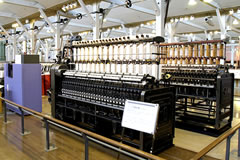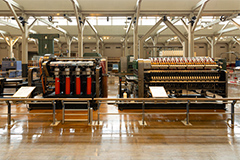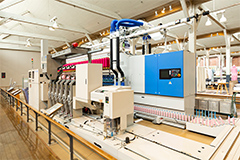The Development of Spinning Machinery Technology
It was before 5,000 B.C. when humans started spinning threads and making fabric. They are the two of the oldest technologies that mankind invented. However, the fundamental work involved in spinning and weaving has not changed between then and now. The advancement in technology was driven by the measures concerning how fast with less effort to process the work. Rudimental spinning and weaving tools, as well as early mechanized spinning machines, are exhibited in the first section at the Textile Machinery Pavilion. Even the current state-of-the-art technologies budded from these fundamental techniques.
Japan’s Ingenious Technologies

The Garabo throstle spinning machine, invented by Tokimune Gaun, an engineer from Shinano (present Nagano Prefecture), in 1873 was in the limelight as a spinning machine made out of Japan’s own technology and spread all over Japan. You can spin a yarn by turning the Garabo throstle spinning machine. A dynamic exhibit of one of the power-driven Garabo throstle spinning machines currently in use is also presented.

(Filmed on August, 2019)
The Import of Western European Technologies and Japan’s Machine Spinning

By the time Japan invented the hand-turning Garabo throstle spinning machine, England had already been mass producing higher quality yarn by mechanical spinning systems. “It is important to produce high-quality yarn to weave high-quality fabric.” Japan imported the technology from Western Europe. A roving frame and a ring spinning frame that were manufactured by Platt Brothers & Co., Ltd. of England about 100 years ago and seven other pieces of textile machinery used in each process in the mechanical spinning system developed in Japan based on the imported machines and those manufactured by Toyoda Automatic Loom Works, Ltd.

(Filmed on August, 2019)

(Filmed on August, 2019)

(Filmed on August, 2019)
Establishment of Domestic Technologies

As Japan’s own technology was developed by improving on the Western technologies from the Taisho era into the early Showa era, the breakthrough super high draft ring spinning frame, which eliminated the roving process, invented by Kiichiro Toyoda, particularly contributed to the rationalization in spinning. The world’s first spinning machines developed in Japan, including the Toyoda continuous automatic spinning system, which innovatively saved labor.
Diversification and Sophistication: Fully Automated Spinning System

A fully automated spinning system was developed in Japan in response to the spinning industry’s demand for increased speed and labor saving in the 1980s. You can watch yarn being spun at lightning speed from the exhibited high-speed carding machine, high-speed drawing frame, high-speed roving frame, and high-speed spinning frame. All humans do is supervise to prevent machine errors from happening. This is the latest system that realized full automation with a computer controlling the entire processes.

